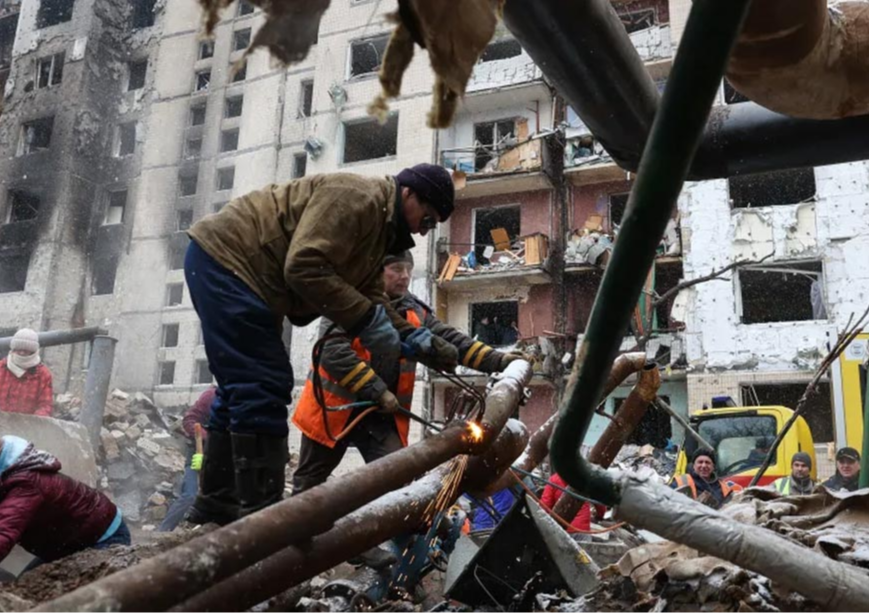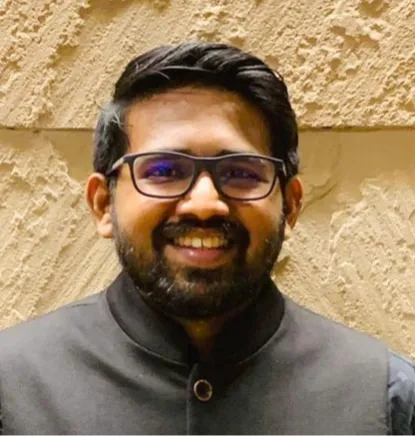
Source Image: Anatolii Stepanov/AFP
In March 2024, it came to light that several Indian, Sri Lankan, and Nepali nationals have joined the Russian army and are fighting Ukraine on the frontlines. With less than a week’s training, these soldiers are being used expendably. Media reports suggest that at least 12 Nepalis, five Sri Lankans, and two Indians have been killed on the Ukrainian front lines so far. The demand for foreign labour in Russia, economic incentives, and the militarisation of South Asian societies are fuelling this foreign fighters phenomenon. However, being subject to harsh conditions, South Asians are now requesting their respective governments for repatriation, and the latter have raised their concerns with Russia diplomatically. State capacities and bilateral relations of these South Asian nations with Russia will play a crucial role in this process.
The demand for foreign labour in Russia, economic incentives, and the militarisation of South Asian societies are fuelling this foreign fighters phenomenon.
The push-pull factors
The onset of the Russia-Ukraine war has seen a surge in demand for foreign labour in Russia. In 2023, a labour shortage of 4.8 million workers was reported. This increase in demand is likely due to the ramping up of military spending and infrastructure projects in the newly occupied territories in Ukraine. As the war continues, the number of people serving in the armed forces has increased by 7.2 percent in 2022 and 8.3 percent in 2023. This is an increase from 1,902,758 in 2021 to 2,039,758 in 2022 and 2,209,130 in 2023. There is also a possibility of another round of mobilization this year. To address the labour shortages, Russia offers higher pay and citizenship to migrant workers joining as labourers or military helpers and fighters on the front lines.
On the other hand, South Asia has witnessed increasing outward migration in recent years for higher wages and better living standards. The 2022 economic crisis in Sri Lanka, the economic recession in Nepal, and unemployment in both countries have triggered an exodus. For India, whose economy has been resilient despite the COVID-19 pandemic and the Russia-Ukraine War, higher wages offered in Russia have continued to attract some to migrate. At the least, these South Asian workers can earn US$550 (equivalent to INR 45,000) a month in Russia. The payment for working as a helper or porter in the newly occupied regions is more than US$2,000 a month (equivalent to INR 160,000), incentivising several South Asian migrants to move to Russia.
The 2022 economic crisis in Sri Lanka, the economic recession in Nepal, and unemployment in both countries have triggered an exodus.
In addition, both Nepal and Sri Lanka are militarised societies. In these countries, military recruitment is often used as a policy measure to reduce unemployment. The prospect of earning US$2,000 per month further acts as an incentive to serve in the Russian military. For several Nepalis who used to serve in the Gorkha regiments of the Indian Army, recruitment has been at a standstill since the launch of the Agniveer scheme, motivating some of them to join the Russian military. In Sri Lanka, the legacy of the civil war and prospects of higher earnings are motivating several retired defence personnel and serving soldiers to fight for Russia.
Recruitment strategies
The recruitment of South Asians in the Russian military is both voluntary and involuntary. Nepal’s Prime Minister P.K. Dahal, revealed that more than 200 Nepalis served in the Russian army in December 2023. Other estimates indicate that this number is closer to 700. Media sources cite hundreds of Sri Lankans serving in the Russian military, and over 100 Indians are said to be working with the Russian armed forces.
In several instances, individuals have travelled on tourist visas to join the army. Interestingly, the number of tourist visas from these countries has increased with the onset of the war. In 2021, more than 7,132 Indians migrated to Russia, and the number in 2022 surged to 8,275 despite the onset of the war. In the first half of 2023, with the introduction of an e-visa for Indian tourists, travel from India to Russia for tourism increased by 56 percent. In Nepal too, migrants have likely used tourist visas to join the Russian army. Between 2021-2022, only one registered private agency facilitated Nepali labour’s migration to Russia. But, on the contrary, more than 1,039 Nepalis entered Russia with a tourist visa in 2023. Direct migration to Russia from Sri Lanka is also scarce. In 2022, an estimated 389 Sri Lankans lived in Russia. Media reports suggest that this figure has increased significantly. However, a worrying trend is that Sri Lankans employed in the Middle East—a popular destination that accounts for 88 percent of the country’s migration—are leaving their jobs to fight in the war.
The owner of Baba Vlogs, Faisal Khan, was arrested by the Central Bureau of Investigation, India, for allegedly duping these workers to join the Russian military.
In certain instances, a complex interlinkage of the middle person is at play. Several Indians, Nepalis, and Sri Lankans are duped by promising good jobs and citizenship. In the case of India, several Indians were misinformed through vlogs and YouTube channels. For instance, The owner of Baba Vlogs, Faisal Khan, was arrested by the Central Bureau of Investigation, India, for allegedly duping these workers to join the Russian military. The case is similar in Sri Lanka, where 17 workers were tricked into seeking work as sweepers, helpers, or security guards, and they were later duped into joining the army on the frontline. The CID in Sri Lanka and the police in Nepal have begun cracking down on middlemen and recruitment agencies duping its citizens. Russian authorities have been complicit in this phenomenon in some cases. For instance, some Indian travellers were given a choice to serve in the army or be imprisoned for ten years when they were detained for travelling from Russia to Belarus without a visa.
State capacity
Russia’s ability to benefit from the situation and the South Asian countries’ ability to repatriate their citizens are closely intertwined with the former's South Asia policy, post-Ukraine invasion.
As the Indo-Pacific region grows in prominence, Russia is keen on expanding its presence in the South Asian region. This interest has increased further following its invasion of Ukraine and the diplomatic isolation by the West. India is its largest and most reliable partner in the region. Since February 2022, India-Russia relations have considerably improved. India abstained in the United Nations General Assembly vote on Russia’s aggression on Ukraine, and India’s bilateral trade with Russia has significantly increased from US$13.2 billion in FY 2021-22 to US$50 billion in 2023. This is due to the purchase of cheap crude oil. Since the invasion of Ukraine, India has also emerged as a laundromat nation in the World by refining and exporting Russian oil across the globe, helping keep the Russian economy in shape.
India abstained in the United Nations General Assembly vote on Russia’s aggression on Ukraine, and India’s bilateral trade with Russia has significantly increased from US$13.2 billion in FY 2021-22 to US$50 billion in 2023.
Russia’s search for new markets coincided with Sri Lanka’s economic crisis and neutrality towards the Russia-Ukraine war, thus contributing to the former’s proactive role. Not only have Russian tourists been crucial in reviving the Sri Lankan economy, but Russia has also exported cheap oil, expressed keen interest in a joint venture with India to run the Hambantota International Airport, and has reportedly agreed to help build a nuclear power plant. This is also one of the reasons Sri Lanka hesitated to end long-term visas of Russian citizens on short notice. In Nepal, Russia’s invasion of Ukraine has impacted its non-alignment stance and invoked some criticism from Moscow. Nepal’s voting in the United Nations continues to run against Russian interests. There is also very little progress in the country’s cooperation on development cooperation, hydropower, infrastructure, light metro, railway construction, and establishment of direct flights.
The nature of bilateral cooperation is likely to impact the bargaining leverage of these South Asian countries. The Indian Ministry of External Affairs has been in touch with the Russian government to get an early discharge of Indians into the Russian army. Several Indians are discharged and other cases have been taken up with the Russian authorities. Considering that a large segment of Indians was duped into working for the Russian military, conclusive proof helped in seeking early discharge.
The Nepali Ministry of Foreign Affairs has sent two notes to Russia to repatriate its citizens who have been fighting in the war and is requesting details on the names and the status of Nepalis serving in the armed forces, to no avail.
Nepal and Sri Lanka, on the other hand, have not been as successful as India. Since January, the Nepali Ministry of Foreign Affairs has sent two notes to Russia to repatriate its citizens who have been fighting in the war and is requesting details on the names and the status of Nepalis serving in the armed forces, to no avail. In a recent video, Nepali citizens fighting in the Russian army also appealed to the Indian MEA to help them. In January, Nepal stopped issuing permits to work in Russia and Ukraine and, banned travel for non-official purposes. In Sri Lanka, the Ministry of Defence has denied any involvement in the Sri Lankan soldiers joining the war and has also instructed the military personnel to not join the war. However, little has been commented on the repatriation of Sri Lankan civilians fighting in Russia. Indirect and, in some cases, illegal migration, along with their weaker state capacity and fewer leverages with Russia, contributes to this weak response from Moscow.
Conclusion
As the Russia-Ukraine war continues, South Asians are being forced to fight at the forefront. Since Russia does not have the required manpower, it will continue to depend on offering contracts to migrant workers. Higher wages and prospects of citizenship have always been a pull factor for migrants in South Asia. However, state capacities and bilateral relations with Russia will largely define their ability to repatriate the citizens.
Aditya Gowdara Shivamurthy is an Associate Fellow at the Observer Research Foundation
Rajoli Siddharth Jayaprakash is a Research Assistant at the Observer Research Foundation
The views expressed above belong to the author(s). ORF research and analyses now available on Telegram! Click here to access our curated content — blogs, longforms and interviews.




 PREV
PREV



